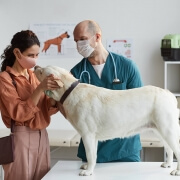A fresh mind! See your practice from a different point of view.
There is a good chance that you have welcomed a number of new customers and pets to your practice this year – no doubt you will have seen your share of puppies, kittens, and shelter animals. So it’s worth remembering that some new customers will also have had their first visit to your practice – and perhaps even their first trip to a veterinary practice. These customers may not be familiar with practice processes and may be overwhelmed by their visit. That is why every now and then it’s good to put yourself in their position and see your practice from their point of view. Here are our five tips for seeing your practice through your customer’s eyes.
1. A part of the family
Commonly, pets are considered to be full members of the family – we frequently observe high-pitched baby voices when talking to animals, we give holiday advice on pet-friendly locations, and of course – pet-selfies. Conversely, we there are also animals that do not have their own Instagram account or with who don’t get to sleep on the bed!
Every pet-owner is different and we shouldn’t judge a pet owner based on their interest in sensitive to advise and information when in the consultation room. Try not to judge these moments, and work to inform the family member who is actively participating in the consultation as well as possible.
2. Encourage curiosity
“What happens behind that door?”
Some customers are curious about what happens “behind the scenes” at your practice. A tour of the treatment room, admission, x-ray, and operating room can help the pet owner to understand what happens in your practice and will put their mind at ease. If you hear this request often, consider organising an open day including a full tour of your practice; invite your customers, encourage them to tell their friends, you’ll probably get some new customers too.
3. Tiny inconveniences – fleas, ticks and worms
Often easy to solve with a pipette, a pill or an injection, but these little annoyances are often a major problem for a pet owner. The idea that their beloved pet has worms and is ‘dirty’ is not a pleasant thought. In addition, a lot of information can be found easily online, so that customers can no longer see the forest for the trees – resulting in confusion and often a lack of action.
Therefore, take the requests for advice seriously – don’t wave it away simply with “one pipette and they go away”. Remember that the customer asks for your help because of your expertise and reliability (why else would you delve into the life cycle of the flea and the zoonotic potential?).
Advise the pet owner kindly and sincerely. These customers will probably also appreciate it if they are informed in time about preventive care and treatments in the future – so don’t forget to set those automated reminders!
4. Don’t put the blame on someone else
It happens in every practice that someone finds your practice “too expensive”, or they don’t know what a “paraveterinary worker” is, or that their pet must be kept on a lead in the waiting room.
It is nobody’s fault that the “culture at the vet” is not understood. Most people’s expectations of a veterinary practice come TV courtesy of Supervet or All Creatures Great and Small, which typically show more extreme cases. Be patient, explain to customers what you expect from them and you will see that the concept yields. That also brings us directly to the final tip…
5. Avoid tricky technical words
Ovariohysterectomy, laparoscopy, patella luxation, zoonosis and even parasites. These are words that are familiar to you but probably not for your customers. For fear of feeling stupid, most customers will unfortunately not ask for an explanation when they have not understood it.
If you like to use “technical” words, please bear in mind that they will also be explained in detail. Also, pay attention to non-verbal responses which indicate that the customer may not be following your explanation Remember that not all customers are equally involved, trained or understood with regard to medical terms.
Let’s talk about what IDEXX software can do for your practice
Complete the form below and we’ll get back to you.







